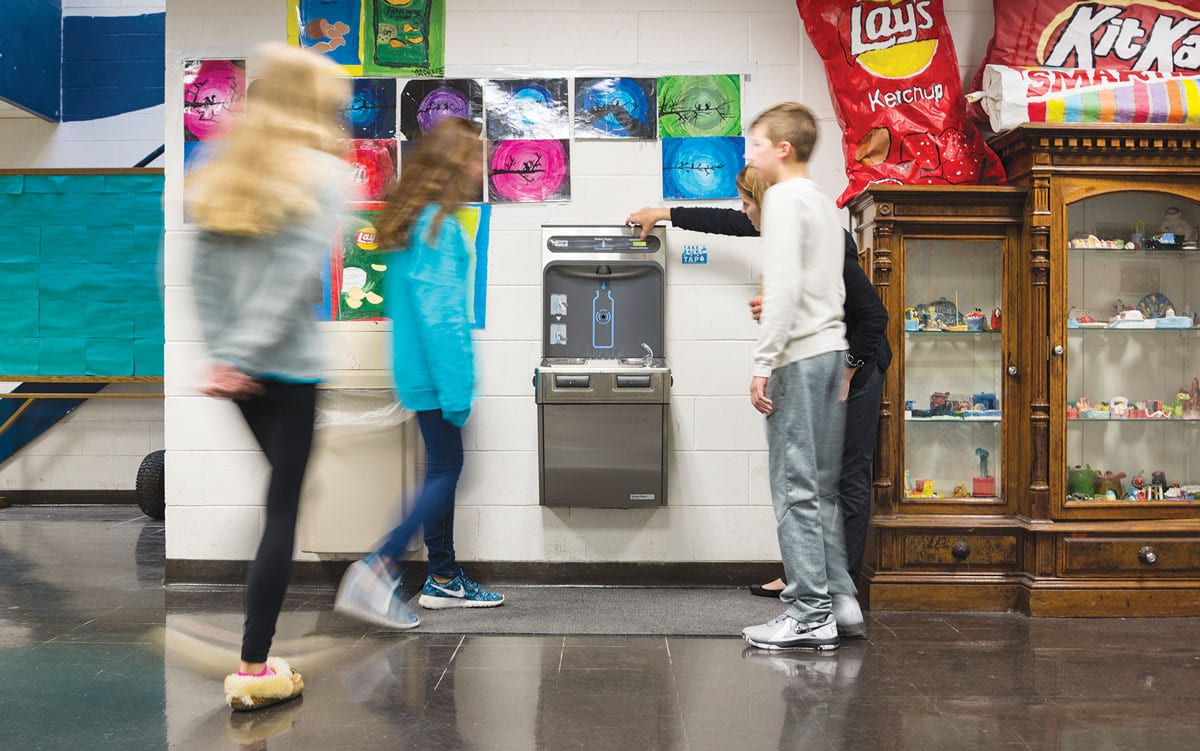SWAMPSCOTT — After a two-year effort, two water refill stations were installed at Swampscott Middle School last month to cut down on waste and continue the school’s recycling efforts.
“Thanks to our friends at the PTO (Parent Teacher Organization), For The Love of Swampscott and two of our teachers, Mr. (William) Andrake and Mrs. (Erica) Vanderhoof, Swampscott Middle School now has two water refill stations,” said middle school Principal Jason Calichman in a blog post. “These stations are not only environmentally friendly, but will also (allow) us to track water consumption at our school.”
Calichman said the first water refill station is located outside the first-floor teacher’s room and the second one sits in the sixth grade hallway.
Andrake, an eighth grade science teacher, said the water refill stations were installed at the school on Sept. 22. The final price was about $4,500, which was funded by the PTO and paid for two refill stations and for the plumber and installation. Plumbing was provided by Aaron Hanson, a former student at the middle school, and his crew.
Andrake said the stations were originally Vanderhoof’s idea two years ago. He said she had talked about it and he later went to a conference where there were water refill stations. He saw a counter on them that kept track of the water usage from the refill stations and decided that it was a good idea to try to get them at the school after initially being unsure.
The two teachers spoke to the PTO and Swampscott Rotary Club to see if they could help out and also applied for a grant from the Swampscott Education Foundation to get them throughout the school, which was denied. For The Love of Swampscott also wanted to help, but the local nonprofit was unable to get funding, Andrake said.
The goal with trying to get refill stations was to change the school’s culture of waste with using disposable water bottles, Andrake said. He said bottles were being found everywhere and were being left in classrooms.
“Basically what they do is they provide a way for students to come in and teachers to come in with their own bottles,” Andrake said.
Andrake said the refill stations are water fountains, but they have the added feature of having a sensor that fills the water bottle, and a counter that keeps track of how many refills there are.
In less than a month since the refill stations have been installed at the school, Andrake said there have been 2,600 bottles of water provided by them, which translates to 2,600 disposable water bottles.
“Basically, we’ve kept over 2,600 water bottles out of the waste stream by getting water this way,” Andrake said. “I’m seeing fewer and fewer disposable water bottles in the hallways and less carelessly discarded around the building.”
Andrake said he’s expecting improvements to the health of the school’s population, as people are drinking more water. He said another positive result of the refill stations is water conservation, as it can take three liters of water to produce a 1 liter disposable water bottle.
Andrake said that two weeks ago, the school’s recycling club counted 245 water bottles in the recycling bin, and 171 last week in the bins. He expects those numbers to keep going down every week, and hopes that by announcing the numbers at school, students will be encouraged to get away from bottled water.
Calichman said in a phone interview that the school is very conscious and cognizant of the environment. He said the school’s recycling club is run on a volunteer basis by teachers, who are in the dumpsters each week. He said the kids are working hard, which “speaks to the culture and the sort of climate we want here at the middle school.”
Calichman said he hopes announcing water conservation and consumption numbers makes students competitive, and will push them to make a concerted effort to recycle. Andrake said eighth grade math is using the data and bringing it into their curriculum — students are going around and gathering numbers.
Andrake and Calichman said it would be great to get two more refill stations in the school, with one each near the gym and cafeteria, two hot spots in the school where there are only regular water fountains.
Andrake said the hope is that other schools and places in the community also follow suit and try to get their own refill stations installed. Already, he said people from the high school have been emailing him for help to get them installed there.
“I’m really proud of the middle school that we’re the first ones to tackle this,” Calichman said. “It took a lot of work and time for teachers and the PTO.”

